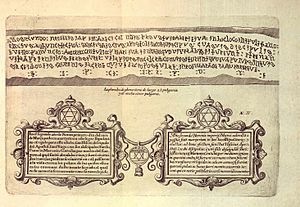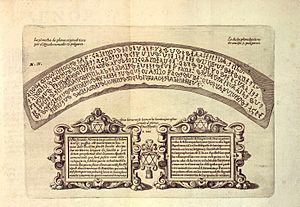Lead Books of Sacromonte facts for kids
The Lead Books of Sacromonte (also called Los Libros Plúmbeos del Sacromonte in Spanish) are a group of old texts. They were written on round pieces of lead. People once thought they were real ancient writings. But now, experts believe they are fake documents made in the 1500s.
History
Discovery of the Books
The Lead Books were found in caves near Granada, Spain. This happened between 1595 and 1606. There were originally 22 books. Each book had round lead pages held together with lead wire. They also had lead covers. Today, three of these books are missing.
The books were found with human bones that had been burned. Lead plaques near the bones said they belonged to Caecilius of Elvira and eleven followers. These people were believed to be early Christians who died for their faith. The books claimed they were written by Arabic-speaking Christians during the Roman times. They were supposedly buried with the remains of these martyrs.
What the Books Said
The Lead Books seemed to be written in a mix of Arabic and Latin. The letters were hard to read. The texts themselves were mysterious and unclear. So, the Catholic leaders had to rely on translators. These translators were Morisco scholars. Moriscos were Muslims in Spain who had been forced to become Christian.
Two main translators were Miguel de Luna and Alonso del Castillo. They lived nearby and helped find some of the books. One book, called the "Libro Mudo" (or "Mute Book"), has never been understood or translated.
The Morisco translators said the books contained teachings from the Blessed Virgin Mary. She supposedly spoke through Saint Peter. She gave instructions for Saint James the Great and Saint Caecilius. They were to go to Spain to teach about Christianity. The books also said Mary loved the Arabic people and their language. She promised to protect the city of Granada.
These books were like an extra part of the Acts of the Apostles from the Bible. They told a different story of how Christianity came to Spain. In this story, Saint Paul was not mentioned. The Virgin Mary's words were supposedly in Latin. But Caecilius was said to have translated them into Arabic.
Important Themes
A key idea in the books was that Arabic was an old language in Spain. They also suggested that Arabs in Granada were among the first Christians in Spain. The books presented Christianity in a way that was appealing to Catholics in Granada. They highlighted the importance of holy objects and the Virgin Mary. They also stressed Granada's importance as a Christian center.
However, the books played down parts of Christianity that Muslims disliked. This included the use of icons (religious images). It also included the idea of the Trinity (God as Father, Son, and Holy Spirit). The books also avoided the idea of worshiping Jesus as God's son. They also did not mention using wine in the Eucharist (a Christian ceremony).
The discovery of these books and the bones was seen as a sign from God. Many people believed they were real because of this. Both King Philip II and King Philip III of Spain supported the findings.
See also
- Sinaia lead plates
- In Spanish: Plomos del Sacromonte para niños




